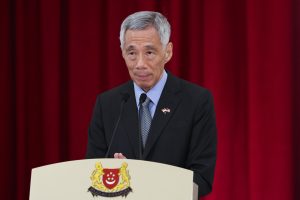As Singapore approaches its sixth year of Prime Minister Lee Hsien Loong’s long and public slide into retirement, we have to ask what is going on at the highest levels of the People’s Action Party (PAP) government. The process of choosing Lee’s successor as prime minister began very publicly in 2016, when a field of six candidates – all ethnic Chinese men with similar educational, social, and professional backgrounds – was floated for public consumption in the mainstream media. This exercise was followed by a two-year process whereby Lee winnowed the field down through carefully calibrated mechanisms, such as the appointment of one candidate as speaker of Parliament in September 2017. Thus, contenders were removed one by one until, in November 2018, Finance Minister Heng Swee Keat was the last man standing.
The rationale for his ultimate selection was just as opaque as the earlier eliminations. After his election as first assistant secretary general of the PAP, unidentified “party sources” belatedly told the press that this outcome had been the final step in the process of selecting the next prime minister.
So far so good, but Heng then engaged in a series of very public blunders, culminating in a spectacularly embarrassing performance during the General Election campaign of 2020, attracting both domestic and international ridicule. The cumulative effect of these episodes was to publicly render Heng unviable as a prime ministerial successor. In April 2021 he stepped aside. But this unprecedented move left the process of leadership renewal in limbo, with nothing but embarrassment to show for more than five years’ careful work and hype. The leadership selection went back to the drawing board, and that is where it remained at the opening of 2022.
From reading the tea leaves, Singaporeans are aware that there are now three or four possible contenders within the Cabinet, and among those four there seem to be two favorites. These are the two men heading the Singapore government’s response to the COVID-19 pandemic: Finance Minister Lawrence Wong and Health Minister Ong Ye Kung. Beyond these slivers of speculation, however, it is all something of a mystery because the process of selection is still opaque to everyone outside the innermost circles of the country’s ruling elite. Meanwhile Lee, who turned 70 last month, keeps postponing his retirement, but is visibly tired and conspicuously disengaged from the hard work of policy and administrative leadership.
Messy leadership transitions and lingering “lame duck” leaders are traditionally and routinely associated with Western democracies; this situation is unprecedented in Singapore. In fact, the contrast between the unpredictability and flawed outcomes of democracies on the one hand and the usual smoothness and effectiveness of Singapore’s system of leadership selection on the other has long been presented to international business, to the world at large, and to Singaporeans at home as one of the country’s bedrock strengths.

































